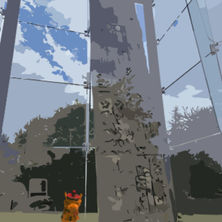top of page

Places To Go
Adventure to all the wonderful places that Oor Ferghas has.
Whether it's a long adventure trail or just a day out to see the Dolphins, we will show you where to go and what to look out for with this handy guide.
Google locations are provided at the bottom of each log to show you exactly where to go.
More locations being added constantly so keep an eye and let us know if you visit any yourself

Need help?
Ask ICoo



Huntly Castle
Huntly Castle is a richly carved ruin in Aberdeenshire, once home to the powerful Gordon family. It offers layered history, dramatic architecture, and a peaceful riverside setting ideal for heritage lovers and photographers. Highlights Seat of the Earls of Huntly : The castle was a stronghold of the influential Gordon family from the 15th to 17th centuries. Heraldic Stonework : Intricate carvings of coats of arms, Latin inscriptions, and Renaissance friezes decorate the façad


East Aquhorthies Stone Circle
East Aquhorthies Stone Circle is one of Scotland’s best-preserved recumbent stone circles, offering mystical ambience, panoramic views, and easy access near Inverurie. Highlights Complete Recumbent Stone Circle : Unlike many sites, East Aquhorthies retains its full ring of stones, including the massive recumbent stone flanked by upright grey granite pillars. Unique Stone Selection : Most stones are pinkish porphyry, but the recumbent is red granite from Bennachie, and one is


The Maiden Stone
The Maiden Stone near Inverurie is a striking Pictish monument with mythic allure, intricate carvings, and easy access best viewed April to October. Highlights Class II Pictish Cross-Slab : Carved from red granite, this 3-meter-high stone features a ring-headed cross, mythical beasts, and iconic Pictish symbols like the mirror and comb, Z-rod, and centaur-like figures. Legend of the Maiden : Local lore tells of a laird’s daughter who lost a bet with the devil and was turned t


Brandsbutt Stone
The Brandsbutt Stone in Inverurie is a striking Class I Pictish monument featuring mysterious symbols and rare ogham script—perfect for a quick, lore-rich stop on a heritage trail. Highlights Class I Pictish Stone : Carved around AD 600, this dark whinstone slab features classic Pictish symbols— a crescent and V-rod above a serpent and Z-rod —etched with bold precision. Ogham Inscription : Along the left edge runs an ogham script reading IRATADDOARENS , possibly referencing E


Urquhart Castle
Perched on the banks of Loch Ness , Urquhart Castle is one of Scotland’s most iconic ruins, steeped in over a thousand years of history....


Elgin Cathedral
Elgin Cathedral serves as a prominent landmark and towering beacon within the urban landscape of Elgin. This once magnificent hall was the pride of Moray's bishops until it was attacked by the Wolf of Badenoch in 1390, followed by years of deterioration that led to the crumbling of several parts. Since the 1800s, the cathedral has attracted numerous tourists, and efforts to preserve the main towers and chapel have transformed it from a mere ruin into a museum dedicated to Mor


Burghead Pictish Fort and Well
Burghead is a peaceful coastal village located on the shores of the Moray Firth in northeast Scotland. This charming destination offers a rich tapestry of history and natural beauty. Highlights Go to the visitor centre to discover the history of the area from around 400 AD to the present day. Explore the ancient fort that showcases the heritage of the Pictish people. Visit the historical well providing insight into the life of early inhabitants. Practical Information In addit


Balvenie Castle
History of Balvenie Castle For over five centuries, Balvenie served as a formidable fortress, initially for the Comyn earls of Buchan, who governed this region of north-east Scotland. In 1306, Robert the Bruce defeated these influential lords, capturing Balvenie Castle in 1308. Highlights Construction Period: 1200s Original Purpose: Seat of the earls of Buchan Transformation: Became an elegant lodging in the 1500s Curtain Walls: Striking design that enhances the castle's


Auchindoun Castle
Auchindoun Castle has a rich and tumultuous history, marked by conflict and tragedy. In 1567, Auchindoun was sold to Sir Adam Gordon. His tenure is noted for his notorious actions during a feud. Sir Adam Gordon gained infamy for the murder of all the occupants of Corgarff Castle in 1571, a brutal act that highlighted the violent rivalries of the time. In retaliation for the massacre at Corgarff, William Mackintosh burned Auchindoun Castle, marking a significant event in th


Highland Coos (Balvenie Castle)
While visiting Balvenie Castle a visit to the local heard is a must see treat. Just up the hill from the Castle they can be seen grazing and occasionally being treated to their favourite treats bread and butteries. Highlights Highland Coos that can be spotted Charlie Hector Lilly Jayjay Gracie Jackie Tips for Visitors Talk to the staff at Balvenie Castle as they often feed the Coo's and can tell you all about them. Do not attempt to feed yourself Do not enter the field Wash


Kinloss Abbey
Just off the main route through Kinloss is the site of ruins, which from the main road doesn't look like much, but once approached is a rich testament to Scottish history and resilience. The abbey stands as a lasting monument to faith. The graveyard is still in use today by locals and regular tours are provided in the area. Highlights The main free-standing structure seen in the centre of the Abbey is the South Transept, which is associated with the following: Chapel Sacristy


Sueno's Stone
Sueno’s Stone is renowned for its intricate carvings and serves as an important cultural artifact, reflecting the artistry and beliefs of the Pictish people during its time. Highlights Carved from local sandstone and standing about 7 meters tall, Sueno’s Stone is a marvel of late Pictish art. It was carved between the mid AD 800s and early AD 900s. Practical Information Height: Approximately 7 meters Material: Local sandstone Period: Late Pictish era (mid AD 800s to early AD
Google Map View
All our locations have been mapped with google so you can find your next adventure easier
Use the pull out tab (top left of the map) to search by area
This map is geo tagged but does not integrate with our location database.
The Tag Bar
Still can't what your looking for?
Search our keywords at the Tag bar
bottom of page


